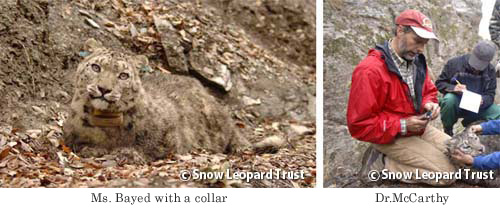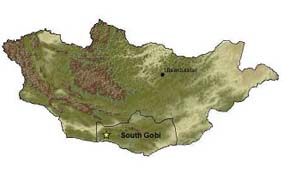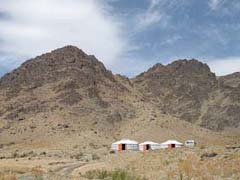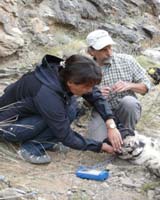Snow Leopard Update
2. The Snow Leopard Trust Long Term Snow Leopard Study in Mongolia
By Ms. Rana Bayrakci, Dr.Kim Murray, and Dr.Tom McCarthy
1. A brief update on Ms.Bayed, the female snow leopard once radio collared in Pakistan.
By Ms. Rana Bayrakci, Dr.Kim Murray, and Dr.Tom McCarthy
Our first GPS radio collaring project began in Pakistan in November 2006. The female named “Bayed” was the first snow leopard fitted with a satellite GPS radio collar that released from her neck as planned in January 2008. The collar fell off inside a tiny hillside cave hidden by snow in the buffer zone of Chitral Gol National Park. Our dedicated field staff was finally able to locate the collar in April 2008.
Bayed was the snow leopard featured with her cub in three television programs: Snow Leopard: Beyond the Myth (BBC Natural World series), Snow Leopard's Lair (Mutual of Omaha production based on the BBC program), and in the Mountains episode of Planet Earth from Discovery Channel.
Due to political instability in the region, we were unable to continue the Pakistan collaring project but hope to return in the future. In the meantime, SLT staff in Pakistan continue to visually monitor signs of snow leopard in the Chitral Gol National Park. Bayed was most recently observed in the park in January 2009.

(This picture is an extract from APRSAF Website)
2. The Snow Leopard Trust Long Term Snow Leopard Study in Mongolia
By Ms. Rana Bayrakci, Dr.Kim Murray, and Dr.Tom McCarthy
In May 2008, the Snow Leopard Trust (SLT) established the J. Tserendeleg Snow Leopard Research Center in the South Gobi Province of Mongolia(Fig1). Located in the Tost Mountains, the research center is situated in some of Mongolia's best snow leopard habitat where SLT has had an active conservation program (Snow Leopard Enterprises) for nearly a decade. Named in honor of one of Mongolia's most respected conservationists, the state-of-the-art facility consists of three gers (tents)(Fig2). Future plans include installation of a solar power system and an information center for local people and tourists.

Figure 1. Location of SLT's Snow Leopard Research Center in the Gob Province of Mongolia.(Extract from Progress Report)

Figure 2. The J. Tserendeleg Snow Leopard Research Center.(Extract from Progress Report)
In June 2008, the Trust deployed remote cameras in the vicinity of our study site to confirm snow leopard presence and recorded photographs of six different cats. Since last summer, we have confirmed the presence of three additional snow leopards in the study site.
We constructed snares to capture snow leopards in August 2008. Since then, we have fitted six cats with Globalstar satellite GPS radio collars that are programmed to record the cat's location every nine hours and to drop-off the animals after 13 months. To date, we have collared five males and one female:
The first cat was collared in August 2008. The male “Aztai” (meaning “lucky” in Mongolian) weighed 36 kg and was estimated to be 4-5 years old based on body size and the condition of his teeth. He was recaptured on a cold day in February 2009 and recovered from the anesthesia inside a sleeping bag with a hot water bottle!(Fig3)
In September 2008 we collared a second male nicknamed “Longtail” but officially named “Bayartai” which means “go with joy” since the cat was collared on the final field day for some of the researcher team. He was approximately 5-7 years old and large, weighing in at 44 kg. Sadly, Longtail/Bayartai was shot and killed on New Years Day, 2009, by a Mongolian herder while raiding the herder's livestock corral. As a result, we are working with local herders to implement a community-managed livestock insurance program to compensate herders for livestock losses to snow leopards. By reducing the financial impact of livestock losses, the program will ultimately benefit snow leopards and local families by stabilizing household incomes and increasing tolerance for livestock losses. (Fig3)


(Extract from Progress Report)
The third male cat, named "Tsagaan" was collared in February 2009 at the beginning of the Mongolian Tsagaan Tsar holiday. He was a little longer than Longtail/Bayartai but weighed slightly less at 41.5 kg and was estimated to be 4-5 years old. Tsagaan's collar malfunctioned but fortunately he was recaptured one month later and the faulty collar was changed.
The fourth and fifth male cats were collared in April 2009. "Shonkhor" means "falcon" in honor of the pair of endangered falcons nesting at the collaring site. This male weighed a little less than 35 kg and was likely close to two years of age. "Saikhan" (meaning "beautiful" in Mongolian) weighed 33.8 kg and also looked to be two years old. Because they are almost identical in size and weight, it is possible that Saikhan and Shonkhor are brothers that have just dispersed from their mother and are still in her home range. If it is true that Shonkhor and Saikhan are such young cats, it will provide the Trust with an unprecedented opportunity to learn how the movements of younger cats compare with those of adults, and how cubs establish their home ranges. This information has never been documented before, but such information is key to understanding how snow leopards use their habitat so that we can design programs and policies to ensure their survival.
The final snow leopard caught to date was a small female captured last week. Unfortunately, she managed to slip her collar off within the week. We hope to recapture her and re-attach the collar.
The satellite collars are performing well and are allowing us to collect valuable information on the status and movements of the cats, including predation events. For instance, on 4 September 2008 we determined from the location data that one of the collared cats had stayed at the same location for several days. Hiking into the area, we learned that the cat had killed a large 12 year-old male ibex and had been feeding on it for several days.
The information on home range sizes and movements is helping us to evaluate whether we're defining our conservation communities broadly enough to protect snow leopards over their entire home range. We found that the home ranges of some of these male cats overlapped extensively. Instead of using exclusive areas, the cats appear to be relying on the timing of their movements to avoid direct encounters that could result in aggressive confrontations. And, we've learned that these snow leopards are routinely using areas of 1,000 km2 (386 square miles) or more, revealing that we need to define our Snow Leopard Enterprise conservation efforts on a much broader scale than we previously envisioned. Although the project is still in its infancy, the information we're collecting is already yielding insights that will shape the future of snow leopard conservation.
Finally we would like to introduce the following two articles that we have already published.